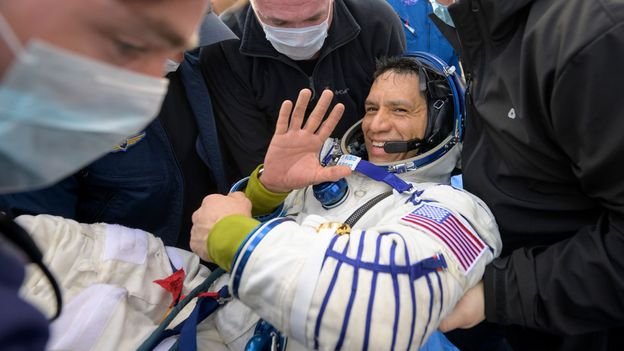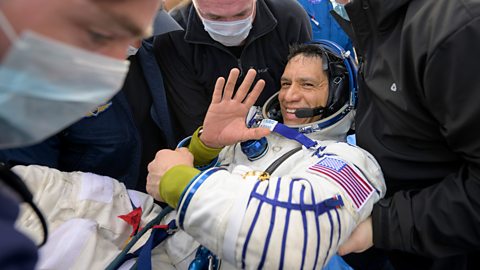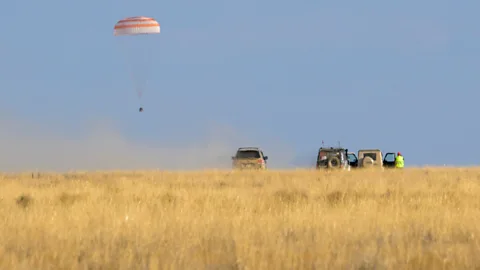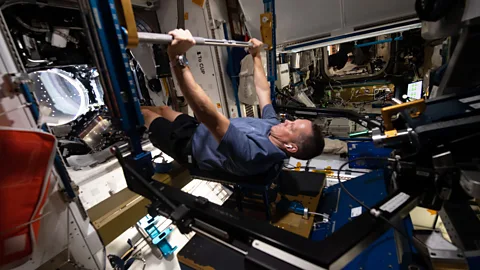What does spending more than a year in space do to the human body?


 Nasa/Getty Images
Nasa/Getty ImagesThe record for a single trip into space currently stands at 371 days, but prolonged periods in orbit alters astronaut’s body’s in some surprising ways, changing their muscles, brains and even their gut bacteria.
With a few handshakes, a brief photoshoot and a wave, Nasa astronaut Frank Rubio bid farewell to the American-football-field-sized collection of modules and solar panels that had been his home for 371 days. His departure from the International Space Station (ISS) and return to Earth marked the end of the longest single spaceflight by an American to date.
His time in orbit – which surpassed the previous US record of 355 consecutive days – was extended in March 2023 after the spacecraft he and his crewmates had been due to fly home in developed a coolant leak. The extra months in space allowed Rubio to clock up a total of 5,963 orbits around the Earth, travelling 157.4 million miles (253.3 million km). Even so, he was still around two months short of the record for the longest ever spaceflight by a human – Russian cosmonaut Valeri Polyakov spent 437 days onboard the Mir Space Station in the mid 1990s.
With a huge grin on his face, Rubio was carried from the Soyuz MS-23 spacecraft after it bumped safely back to Earth in a cloud of dust near the town of Zhezkazgan in the Kazakhstan Steppe. Spending so much time in the low gravity environment of the ISS had taken a toll on his body, so he had to be lifted out of the capsule by the recovery teams.
It is information that will prove vital as humans set their sights on sending crews on missions to explore deeper into the Solar System. A return journey to Mars, for example, is expected to take around 1,100 days (just over three years) under current plans. The spacecraft they will travel in will be far smaller than the ISS, meaning smaller lightweight exercise devices will be needed.
But problems keeping fit aside, just what does spaceflight do to the human body?
Without the constant tug of gravity on our limbs, muscle and bone mass quickly begins to diminish in space. The most affected are those muscles that help to maintain our posture in our back, neck, calves and quadriceps – in microgravity they no longer have to work nearly as hard and begin to atrophy. After just two weeks muscle mass can fall by as much as 20% and on longer missions of three-to-six months it can fall by 30%.
 Nasa/Getty Images
Nasa/Getty ImagesTo combat this, astronauts undertake 2.5 hours a day of exercise and intense training while in orbit on the ISS. This includes a series of squats, deadlifts, rows and bench presses using a resistive exercise device installed in the ISS’s “gym”, alongside regular bouts tethered to a treadmill and on an exercise bike. They also take diet supplements to help keep their bones as healthy as possible.
The lack of gravity pulling down on their bodies can also mean that astronauts find they grow a little taller during their stay on the ISS as their spines elongate slightly. This can lead to issues such as back pain while in space and slipped disks once back on Earth. During a briefing onboard the ISS ahead of his return to Earth, Rubio himself said his spine was growing and said it might help him to avoid a common neck injury that astronauts can suffer when their spacecraft hit the ground if they try to crane out of their seats to see what is happening.
“I think my spine has extended just enough that I’m kind of wedged into my seat liner, so I shouldn’t move much at all,” he said.
Although weight means very little while in orbit – the microgravity environment means anything not tethered down can float around the ISS habitat freely, including human bodies – maintaining a healthy weight is a challenge while in orbit. Although Nasa tries to ensure its astronauts have a diverse range of nutritious foods, including most recently a few salad leaves grown on board the space station, it can still affect an astronaut’s body. Scott Kelly, a Nasa astronaut who took part in the most extensive study of the effects of long-term spaceflight after staying onboard the ISS for 340 days while his twin brother stayed back on Earth, lost 7% of his body mass while in orbit.
Exposure to galactic cosmic rays and energetic solar particles can also lead to other eye problems. The Earth’s atmosphere helps to protect us from these but once in orbit on the ISS, this protection disappears. While spacecraft can carry shielding to help keep out excess radiation, astronauts onboard the ISS have reported seeing flashes of light in their eyes as cosmic rays and solar particles hit their retina and optical nerves.
After his long stay on the ISS, however, Kelly’s cognitive performance was found to have changed little and had remained relatively the same as his brother’s on the ground. However, researchers did notice that the speed and accuracy of Kelly’s cognitive performance did decrease for around six months after he landed, possibly as his brain readjusted to the Earth’s gravity and his very different lifestyle back home.
A study on a Russian cosmonaut who spent 169 days on the ISS in 2014 also revealed some changes to the brain itself seem to occur while in orbit. It found there were changes in the levels of neural connectivity in parts of the brain relating to motor function – in other words, movement – and also in the vestibular cortex, which plays an important role in orientation, balance and perception of our own motion. This is perhaps unsurprising given the peculiar nature of weightlessness while in space; astronauts often have to learn how to move efficiently without gravity to anchor them to anything and adjust to a world where there is no up or down.
 Nasa/Getty Images
Nasa/Getty ImagesA more recent study has raised concerns about other changes in brain structure that can occur during long-term space missions. Cavities in the brain known as the right lateral and third ventricles (responsible for storing cerebrospinal fluid, providing nutrients to the brain and disposing of waste) can swell and take up to three years to shrink back to normal size.
Although there have now been five Nasa astronauts who have spent more than 300 days in orbit, we have Kelly to thank again for insights into how his skin fared while in orbit. His skin was found to have heightened sensitivity and a rash for around six days after he returned from the space station. Researchers speculated that a lack of skin stimulation during the mission may have contributed to his skin complaint.
 Nasa
NasaOne of the most significant findings from Kelly’s prolonged journey into space were the effects it had on his DNA. At the end of each strand of DNA are structures known as telomeres, which are thought to help protect our genes from damage. As we age, these get shorter, but research on Kelly and other astronauts has revealed that space travel seems to alter the length of these telomeres.
Exactly why this happens is still being unravelled, she says. “We have some clues, but additional long-duration crewmembers – like Rubio, who spent one year in space – will be critical to really characterising and understanding this response and its potential health outcomes.”
One possible cause could be exposure to the complex mix of radiation while in space. Astronauts who experience long-term exposure while in orbit show signs of DNA damage, she says.
 Nasa
NasaThere were also some changes in gene expression – the mechanism that reads the DNA to produce proteins in cells – seen in Kelly that may have been related to his journey into space. Some of these related to the body’s response to DNA damage, bone formation and the immune system’s response to stress. Most of these changes, however, had returned to normal within six months of his return to Earth.
In June 2024, a new study highlighted some potential differences between the way the immune systems of male and female astronauts respond to spaceflight. Using gene expression data from samples obtained from the crew of the SpaceX Inspiration 4 mission, who spent just under three days in orbit in the autumn of 2021, it identified changes in 18 proteins related to the immune system, ageing and muscle growth.
Comparing their gene activity to those of 64 other astronauts on previous missions, the study found in the expression of three proteins that play a role in inflammation compared to before the flight. The men tended to be more sensitive to spaceflight, with more disruption to their gene activity and they took longer to return to a normal state after returning to Earth.
In particular, the researchers found the gene activity of two proteins known as interleukin-6, which helps to control levels of inflammation in the body, and interleukin-8, which is produced to gulde immune cells to sites of infection, were more effected in the men compared to the women. Another protein, called firbrinogen, which is involved in blood clotting, was also affected more in male astronauts.
Kelly received a series of vaccines before, during and after his trip into space and his immune system was found to react normally. But Bailey’s research has found that astronauts do suffer some decreases in white blood cell counts that fall in line with the doses of radiation they receive while in orbit.
There are still many questions to be answered, however, about what impact space travel can have on a bipedal, big-brained species that evolved to live on Earth. As researchers pour over Rubio’s medical tests, blood samples and scans following his 371 days in space, they will doubtless be hoping they will learn more.
* This article was originally published on 27 September 2023. It was updated on 12 June 2024 to include details of the study from the SpaceX Inspiration 4 mission.
Source link





